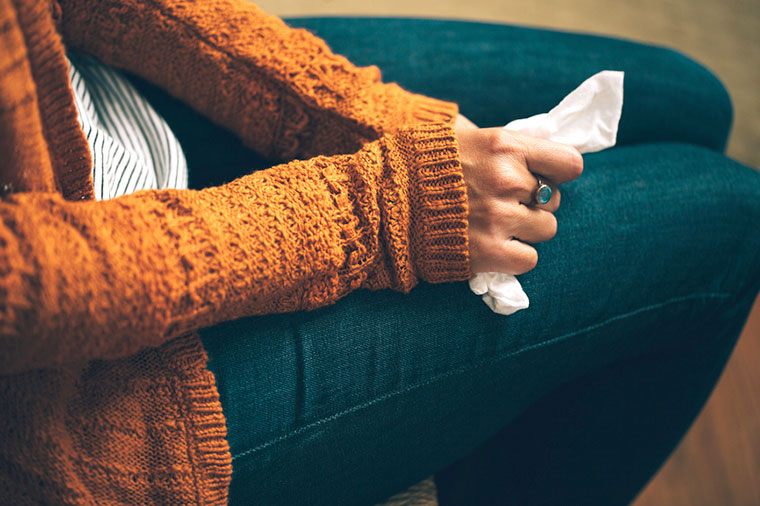The Science Behind Why We Cry

A toddler sobbing in the airplane row behind you is irritating, yes—but, even through gritted teeth, it’s hard not to feel a little envious of their emotional abandon. Social norms dictate that, as an adult, you’re no longer allowed to emote so passionately (or ear-splittingly). But, whether you’re mid-argument with your significant other or two titles into a Lifetime movie marathon, science suggests that the more grown-up, reserved version of crying probably serves a similar purpose as the hungry baby’s hysterics: It’s is thought to signal to our fellow humans (or even to ourselves) that we have a need to be met.
Crying’s purpose hasn’t always been clear (or, all that scientifically reasoned: Back in biblical times, tears were thought to be the result of the heart growing weak and turning into water); in 1872, Charles Darwin famously hypothesized that, while the act of crying helped relieve suffering, the salty streams of liquid rolling down our cheeks serve no actual purpose. Modern scientists largely disagree. Lauren M. Bylsma, PhD, an assistant professor of psychiatry at the University of Pittsburgh’s School of Medicine who’s studied crying and emotional regulation extensively, says our tears may have grown from the alarm calls we, and other species, used as infants into something more complex. “It’s thought that crying has sort of evolved from early mechanisms in animals,” Dr. Bylsma says, “but throughout our evolutionary history, [tears have] developed more of a social function.”
Researchers think crying might have came about as a way to let those around us know that we are in distress.
Essentially, researchers think crying might have came about as a way to let those around us know that we are in distress. Babies don’t actually cry visible tears until they’re between 1 and 3 months old, which Dr. Bylsma says may be further evidence that our physical tearing up developed as a way to quietly draw attention to our suffering without attracting predators. Other scientists have theorized that, because tears can elicit sympathy (from an angry parent perhaps or a stubborn customer service operator), we’ve adapted to using them as a sort of manipulation tool.

However we got these Nicholas-Sparks-induced floodgates in our eyes, there’s no question that crying sets off a powerful physiological and emotional response in our bodies. When something upsets us—or sparks another strong emotion—your limbic system, or the part of your nervous system that handles feelings, alerts the lacrimal gland in your eyes. Writing for The Independent, Nick Knight, PhD, explains that the gland produces tears that can either drain out an opening inside your eyelid and subsequently out your nose (why crying usually requires a box of Kleenex) or overwhelm your ocular drainage system and flow down your face instead. These are known as psychic tears, or tears that are emotionally prompted. (Our eyes also fill up with basal tears—the kind that keeps everything from drying out—and reflex tears—the kind that rinses out stray eyelashes or dust.)
The urge to cry hits different people in different ways, and never hits some at all. “Things like gender, personality, mental health, stress, sleep, medication, developmental age, hormones—all these different things can all change how often people cry as well as in what type of situations,” Dr. Bylsma says.
According to research done by biochemist William H. Frey, PhD, in the 1980s, the two most frequent tear triggers are interpersonal relations (such as arguments) and watching TV or a movie. Another study published in the journal Cross-Culture Research in 2011 examined crying behaviors in 37 countries and found that people in more affluent countries tend to cry more, and that women cry more than men across the board. That last finding is consistent, Dr. Bylsma says, with other emotion expression research. “Women tend to be more emotionally expressive than men in general,” she says.

Dr. Frey was also the person who popularized the idea that psychic tears contain more protein and stress hormones than the I-have-dirt-in-my-eye kind. Those findings are still often cited as evidence that crying is a biological mechanism to soothe us, but Dr. Bylsma and others point out that that research hasn’t been replicated in the decades since it came out.
“When you cry, it sort of forces you to process your emotions and think about what’s bothering you.” —Lauren Bylsma, PhD
Dr. Bylsma has studied whether crying makes people feel better and gotten mixed answers. Often, subjects won’t report relief in the moment, but might say their sob sesh made them feel better when they look back at the crying episode later. She’s also found people say crying provides more release when they’re in a supportive social situation. “We think that that has to do with an indirect relationship—meaning, the social benefit is really what makes you feel better, not the crying by itself,” Dr. Bylsma says.
Still, the idea that crying it all out helps you psychologically may not be totally baseless. Even if there’s more research to be done into its biological function, crying, Dr. Bylsma says, seems to offer some people a way to work through their feelings, whether they have a friend nearby consoling them or not. “When you cry, it sort of forces you to process your emotions and think about what’s bothering you and just sort of deal with that,” she says. “It’s also a sort of cathartic release of emotional tension.”
Now, who needs a tissue?
If you feel yourself starting to tear up, cue a sad song on Spotify: Research shows that crying while listening to music can make you feel happier. And here’s why it’s okay to let the waterworks flow at work.





